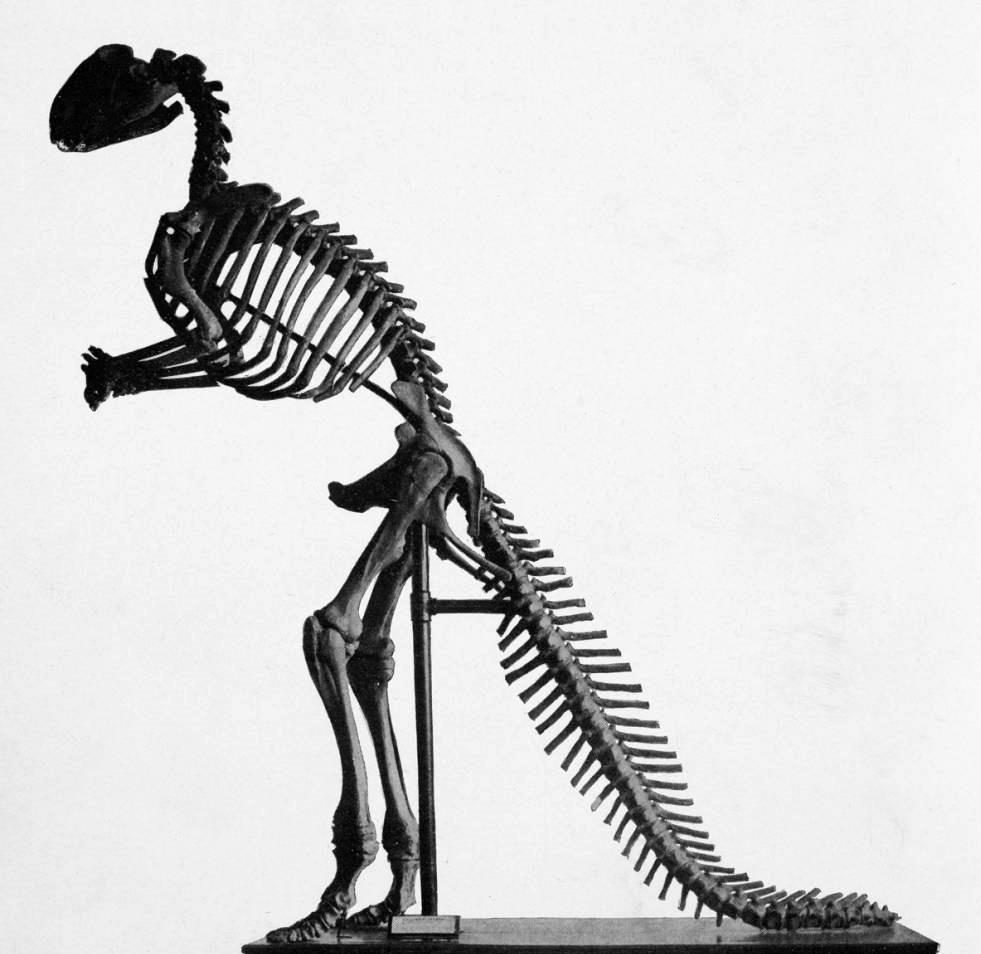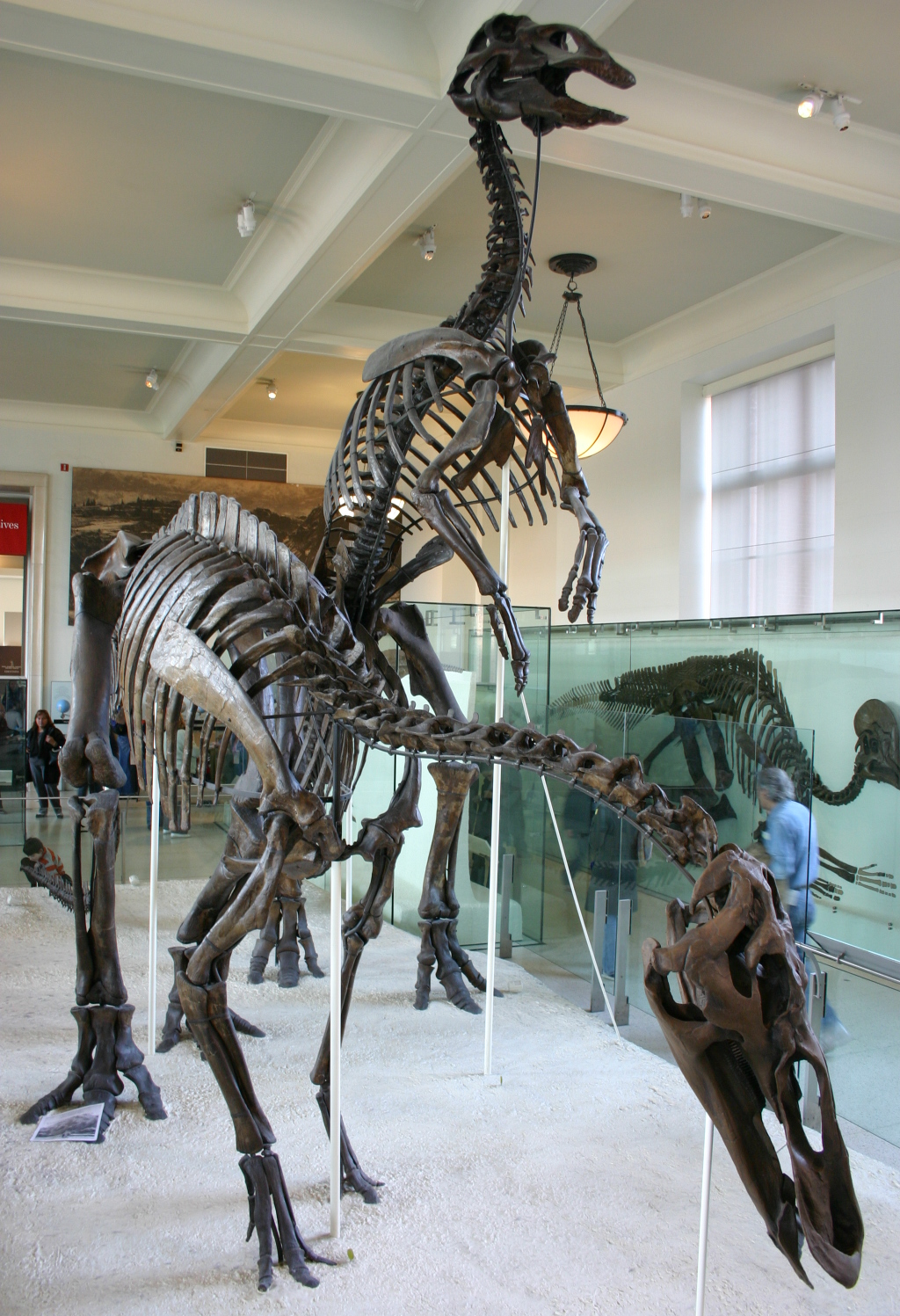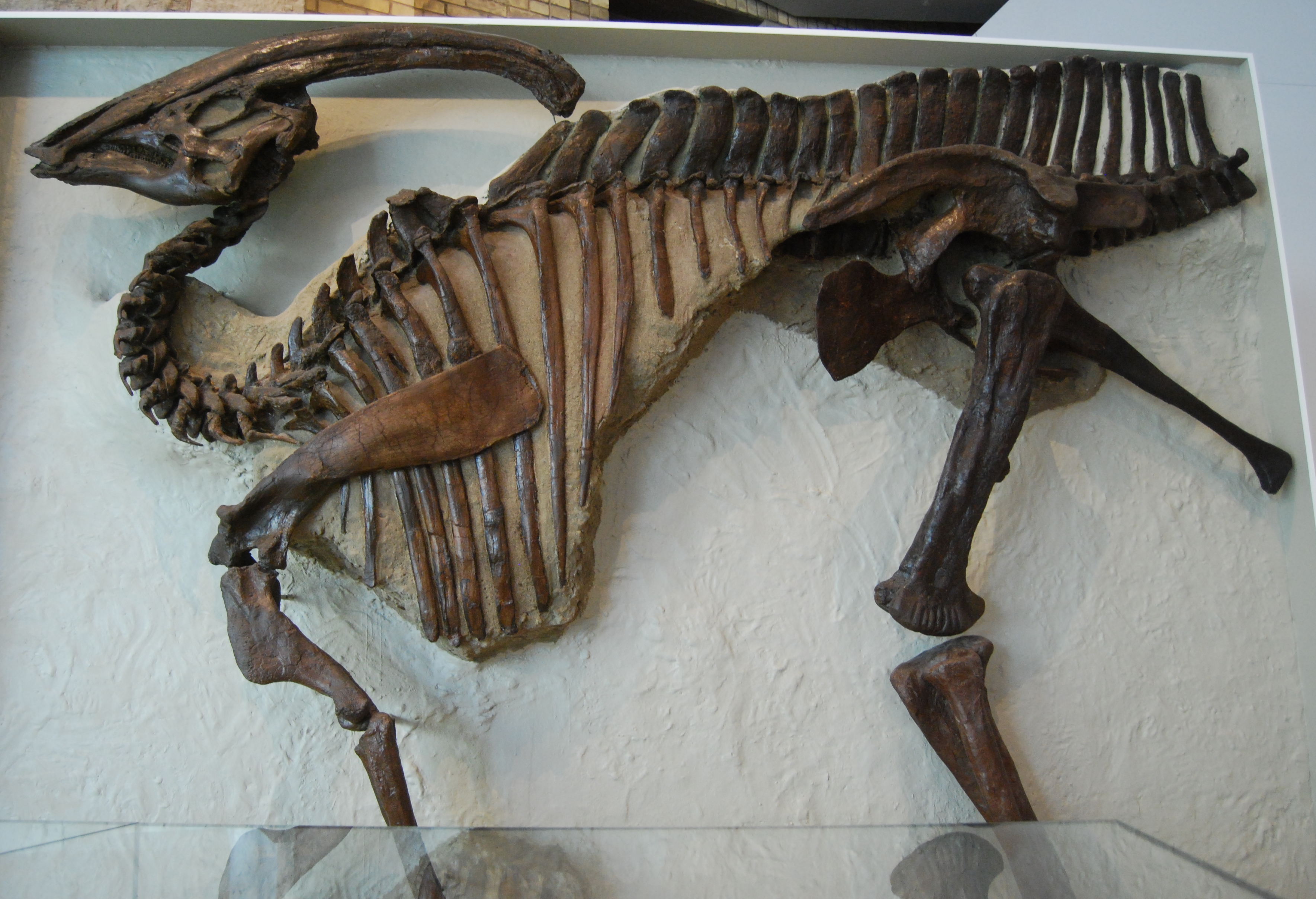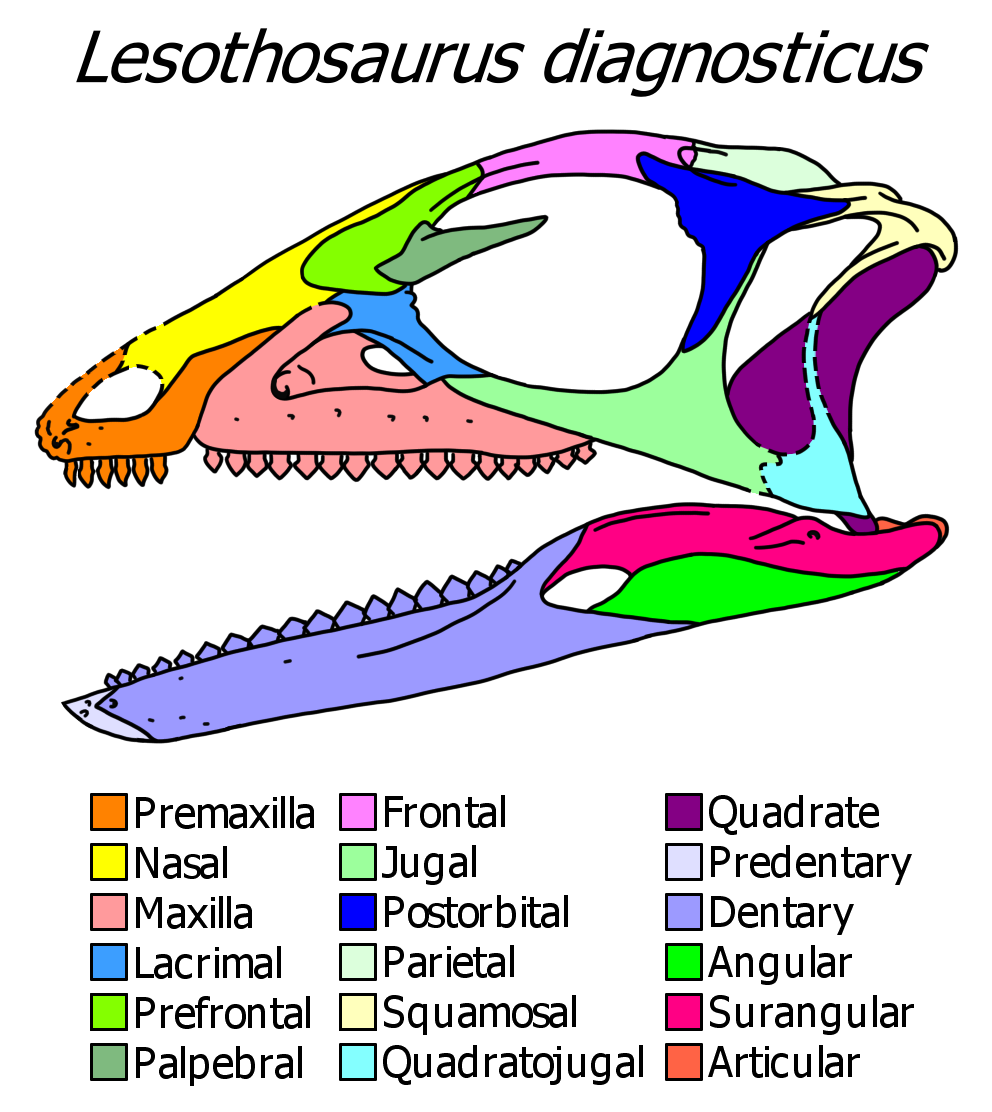|
Hadrosaurinae
Hadrosaurids (), also hadrosaurs or duck-billed dinosaurs, are members of the ornithischian family Hadrosauridae. This group is known as the duck-billed dinosaurs for the flat duck-bill appearance of the bones in their snouts. The ornithopod family, which includes genera such as ''Edmontosaurus'' and ''Parasaurolophus'', was a common group of herbivores during the Late Cretaceous Period (geology), Period. Hadrosaurids are descendants of the Late Jurassic/Early Cretaceous iguanodontian dinosaurs and had a similar body layout. Hadrosaurs were among the most dominant herbivores during the Late Cretaceous in Asia and North America, and during the close of the Cretaceous several lineages dispersed into Europe, Africa, and South America. Like other ornithischians, hadrosaurids had a Glossary of dinosaur anatomy#predentary, predentary bone and a pubic bone which was positioned backwards in the pelvis. Unlike more primitive iguanodonts, the teeth of hadrosaurids are stacked into complex s ... [...More Info...] [...Related Items...] OR: [Wikipedia] [Google] [Baidu] |
Saurolophinae
Saurolophinae is a subfamily (biology), subfamily of hadrosaurid dinosaurs. It has since the mid-20th century generally been called the Hadrosaurinae, a group of largely non-crested hadrosaurs related to the crested sub-family Lambeosaurinae. However, the name Hadrosaurinae is based on the genus ''Hadrosaurus'' which was found in more recent studies to be more primitive than either lambeosaurines or other traditional "hadrosaurines", like ''Edmontosaurus'' and ''Saurolophus''. As a result of this, the name Hadrosaurinae was dropped or restricted to ''Hadrosaurus'' alone, and the subfamily comprising the traditional "hadrosaurines" was renamed the Saurolophinae. Recent phylogenetic work by Hai Xing indicates that ''Hadrosaurus'' is placed within the monophyletic group containing all non-lambeosaurine hadrosaurids. Under this view, the traditional Hadrosaurinae is resurrected, with the Hadrosauridae being divided into two clades: Hadrosaurinae and Lambeosaurinae. Classification Saur ... [...More Info...] [...Related Items...] OR: [Wikipedia] [Google] [Baidu] |
Edmontosaurus
''Edmontosaurus'' ( ) (meaning "lizard from Edmonton"), with the second species often colloquially and historically known as ''Anatosaurus'' or ''Anatotitan'' (meaning "duck lizard" and "giant duck"), is a genus of hadrosaurid (duck-billed) dinosaur. It contains two known species: ''Edmontosaurus regalis'' and ''Edmontosaurus annectens''. Fossils of ''E. regalis'' have been found in rocks of western North America that date from the late Campanian Stage (stratigraphy), age of the Cretaceous Period (geology), period 73 million years ago, while those of ''E. annectens'' were found in the same geographic region from rocks dated to the end of the Maastrichtian age, 66 million years ago. ''Edmontosaurus'' was one of the last non-bird, avian dinosaurs ever to exist, and lived alongside dinosaurs like ''Triceratops'', ''Tyrannosaurus'', ''Ankylosaurus'', and ''Pachycephalosaurus'' shortly before the Cretaceous–Paleogene extinction event. ''Edmontosaurus'' included two of the lar ... [...More Info...] [...Related Items...] OR: [Wikipedia] [Google] [Baidu] |
Lambeosaurinae
Lambeosauridae /ˌlæmbiəˈsɔːraɪniː/ (meaning 'lambe's lizards') is an extinct group of crested hadrosauroid dinosaurs. Description Size Uncertainty surrounds the size of lambeosaurs from the European continent. Hadrosaurs found there, alongside other dinosaurs, have traditionally been considered representatives of the phenomenon of insular dwarfism, as the continent was then made up of many smaller islands. Many fossil remains from the continent are smaller than those of hadrosaurs found elsewhere in the world, with only isolated remains indicating individuals of adult size by the standards of their relatives in North America and Asia. It remains possible, however, that at least some cases instead represent misidentification of juvenile remains.Dalla Vecchia, F. M. (2014). An overview of the latest Cretaceous hadrosauroid record in Europe. Hadrosaurs, 268-297.Dalla Vecchia FM, Gaete R, Riera V, Oms O, Prieto-Márquez A, Vila B, et al. The hadrosauroid record in the Maast ... [...More Info...] [...Related Items...] OR: [Wikipedia] [Google] [Baidu] |
Hadrosaurus Foulkii
''Hadrosaurus'' (; ) is a genus of hadrosaurid ornithopod dinosaurs that lived in North America during the Late Cretaceous Period in what is now the Woodbury Formation in New Jersey about 83.6 to 77.9 Ma. The holotype specimen was found in fluvial marine sedimentation, meaning that the corpse of the animal was transported by a river and washed out to sea. Some fossils are found in the Tar Heel/Coachman Formation. They were large animals ranging from and . Most of the preserved elements are very robust, unusual traits in hadrosaurs. ''Hadrosaurus'' were ponderously built animals equipped with keratinous beaks for cropping foliage and a specialized and complex dentition for food processing. ''Hadrosaurus foulkii'', the only species in this genus, is known from a single specimen consisting of much of the skeleton and parts of the skull. The specimen was collected in 1858 from the Woodbury Formation in New Jersey, US, representing the first dinosaur species known from more than ... [...More Info...] [...Related Items...] OR: [Wikipedia] [Google] [Baidu] |
Hadrosaurus
''Hadrosaurus'' (; ) is a genus of hadrosaurid ornithopod dinosaurs that lived in North America during the Late Cretaceous Period in what is now the Woodbury Formation in New Jersey about 83.6 to 77.9 Ma. The holotype specimen was found in fluvial marine sedimentation, meaning that the corpse of the animal was transported by a river and washed out to sea. Some fossils are found in the Tar Heel/Coachman Formation. They were large animals ranging from and . Most of the preserved elements are very robust, unusual traits in hadrosaurs. ''Hadrosaurus'' were ponderously built animals equipped with keratinous beaks for cropping foliage and a specialized and complex dentition for food processing. ''Hadrosaurus foulkii'', the only species in this genus, is known from a single specimen consisting of much of the skeleton and parts of the skull. The specimen was collected in 1858 from the Woodbury Formation in New Jersey, US, representing the first dinosaur species known from more than ... [...More Info...] [...Related Items...] OR: [Wikipedia] [Google] [Baidu] |
Edmontosaurus Annectens
''Edmontosaurus annectens'' (meaning "connected lizard from Edmonton"), often colloquially and historically known as ''Anatosaurus'' (meaning "duck lizard"), is a species of flat-headed Saurolophinae, saurolophine hadrosaurid dinosaur from the late Maastrichtian Geologic time scale, age at the very end of the Cretaceous Period (geology), period, in what is now western North America. Remains of ''E. annectens'' have been preserved in the Frenchman Formation, Frenchman, Hell Creek Formation, Hell Creek, and Lance Formations. All of these formations are dated to the late Maastrichtian age of the Late Cretaceous period, which represents the last three million years before the Cretaceous–Paleogene boundary, extinction of the non-avian dinosaurs (between 68 and 66 million years agoHoltz, Thomas R. Jr. (2012) ''Dinosaurs: The Most Complete, Up-to-Date Encyclopedia for Dinosaur Lovers of All Ages,'Winter 2011 Appendix./ref>). ''E. annectens'' is also found in the Laramie Formation, ... [...More Info...] [...Related Items...] OR: [Wikipedia] [Google] [Baidu] |
Parasaurolophus
''Parasaurolophus'' (; meaning "beside crested lizard" in reference to ''Saurolophus'') is a genus of hadrosaurid "duck-billed" dinosaur that lived in what is now western North America and possibly Asia during the Late Cretaceous period, about 76.9–73.5 million years ago. It was a large herbivore that could reach over long and weigh over , and were able to move as a biped and a quadruped. Three species are universally recognized: ''P. walkeri'' (the type species), ''P. tubicen'', and the short-crested ''P. cyrtocristatus''. Additionally, a fourth species, ''P. jiayinensis'', has been proposed, although it is more commonly placed in the separate genus '' Charonosaurus''. Remains are known from Alberta, New Mexico, and Utah, as well as possibly Heilongjiang if ''Charonosaurus'' is in fact part of the genus. The genus was first described in 1922 by William Parks from a skull and partial skeleton found in Alberta. ''Parasaurolophus'' was a hadrosaurid, p ... [...More Info...] [...Related Items...] OR: [Wikipedia] [Google] [Baidu] |
Ornithischia
Ornithischia () is an extinct clade of mainly herbivorous dinosaurs characterized by a pelvic structure superficially similar to that of birds. The name ''Ornithischia'', or "bird-hipped", reflects this similarity and is derived from the Greek stem ' (), meaning "bird", and ' (), meaning "hip". However, as theropod dinosaurs, birds are only distantly related to this group. Ornithischians with well known anatomical adaptations include the ceratopsians or "horn-faced" dinosaurs (e.g. ''Triceratops''), the pachycephalosaurs or "thick-headed" dinosaurs, the armored dinosaurs ( Thyreophora) such as stegosaurs and ankylosaurs, and the ornithopods. There is strong evidence that certain groups of ornithischians lived in herds, often segregated by age group, with juveniles forming their own flocks separate from adults. Some were at least partially covered in filamentous (hair- or feather- like) pelts, and there is much debate over whether these filaments found in specimens of '' Ti ... [...More Info...] [...Related Items...] OR: [Wikipedia] [Google] [Baidu] |
Glossary Of Dinosaur Anatomy
This glossary explains technical terms commonly employed in the description of dinosaur body fossils. Besides dinosaur-specific terms, it covers terms with wider usage, when these are of central importance in the study of dinosaurs or when their discussion in the context of dinosaurs is beneficial. The glossary does not cover Trace fossil, ichnological and bone histological terms, nor does it cover measurements. A B C D E F G H I J L M N O P Q R S ... [...More Info...] [...Related Items...] OR: [Wikipedia] [Google] [Baidu] |
Iguanodontia
Ornithopoda () is a clade of ornithischian dinosaurs, called ornithopods (). They represent one of the most successful groups of herbivorous dinosaurs during the Cretaceous. The most primitive members of the group were bipedal and relatively small-sized, while advanced members of the subgroup Iguanodontia became quadrupedal and developed large body size. Their major evolutionary advantage was the progressive development of a chewing apparatus that became the most sophisticated ever developed by a non-avian dinosaur, rivaling that of modern mammals such as the domestic cow. They reached their apex of diversity and ecological dominance in the hadrosaurids (colloquially known as 'duck-bills'), before they were wiped out by the Cretaceous–Paleogene extinction event along with all other non- avian dinosaurs. Members are known worldwide. History of research In 1870, Thomas Henry Huxley listed Iguanodontidae (coined by Edward Drinker Cope a year earlier) as one of his three famil ... [...More Info...] [...Related Items...] OR: [Wikipedia] [Google] [Baidu] |
Early Cretaceous
The Early Cretaceous (geochronology, geochronological name) or the Lower Cretaceous (chronostratigraphy, chronostratigraphic name) is the earlier or lower of the two major divisions of the Cretaceous. It is usually considered to stretch from 143.1 Megaannum#SI prefix multipliers, Ma to 100.5 Ma. Geology Proposals for the exact age of the Barremian–Aptian boundary ranged from 126 to 117 Ma until recently (as of 2019), but based on drillholes in Svalbard the defining Anoxic event#Cretaceous, early Aptian Oceanic Anoxic Event 1a (OAE1a) was dated to 123.1±0.3 Ma, limiting the possible range for the boundary to c. 122–121 Ma. There is a possible link between this anoxic event and a series of Early Cretaceous large igneous provinces (LIP). The Ontong Java Plateau, Ontong Java-Manihiki Plateau, Manihiki-Hikurangi Plateau, Hikurangi large igneous province, emplaced in the South Pacific at c. 120 Ma, is by far the largest LIP in Earth's history. The Onto ... [...More Info...] [...Related Items...] OR: [Wikipedia] [Google] [Baidu] |
Late Jurassic
The Late Jurassic is the third Epoch (geology), epoch of the Jurassic Period, and it spans the geologic time scale, geologic time from 161.5 ± 1.0 to 143.1 ± 0.8 million years ago (Ma), which is preserved in Upper Jurassic stratum, strata.Owen 1987. In European lithostratigraphy, the name "Malm" indicates rocks of Late Jurassic age. In the past, ''Malm'' was also used to indicate the unit of geological time, but this usage is now discouraged to make a clear distinction between lithostratigraphic and geochronologic/chronostratigraphic units. Subdivisions The Late Jurassic is divided into three ages, which correspond with the three (faunal) stages of Upper Jurassic rock: Paleogeography During the Late Jurassic Epoch, Pangaea broke up into two supercontinents, Laurasia to the north, and Gondwana to the south. The result of this break-up was the emergence of the Atlantic Ocean, which initially was relatively narrow. Life forms This epoch is well known for many famous types of d ... [...More Info...] [...Related Items...] OR: [Wikipedia] [Google] [Baidu] |









